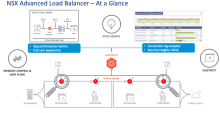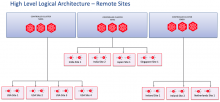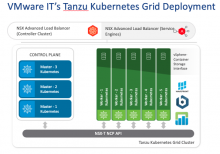by: VMware Director, Solutions Engineering and Design Swapnil Hendre and VMware Associate Manager, Solution Services Preethy G
The load balancer landscape is changing rapidly, and more workloads are being moved to cloud. There is also growing demand for these load balancers to be very elastic. Our legacy load balancer lacked the flexibility, cloud capabilities and the elasticity. Plus, native load balancers provided by major cloud providers were not advanced enough to support our application requirements.
We found a better solution.
The NSX Advanced Load Balancer platform (Avi Networks) delivers automated application services including load balancing, application analytics, predictive autoscaling and security. And importantly, the platform delivers and secures applications with or without VMware NSX® in on-premises or public cloud environments. The platform is built on software-defined principles, runs on standard x86 servers, virtual machines (VMs) or containers, and matches our automation and self-service goals. The Controller runs in the control plane, and manages Service Engines (SEs) that run in the data plane. This separation enhances availability.

Balanced Advantages
The biggest advantages of the new platform are the analytics and logging that make it very easy to isolate the cause of any given issue. Other benefits include a health score more detailed than just red/yellow/green—it provides analytics and a health score that encompasses various metrics like security parameters, number of unavailable pool members, number of client hits missed (packet retransmission) and speed of response (latency).
The platform can be directly integrated with the VMware vCenter® infrastructure to enable horizontal scaling, with the SEs created and deleted based on number of virtual services. And it perfectly aligns with VMware IT’s move to Infrastructure as Code as almost every operation performed is accomplished via open source code, significantly reducing human error and engineer-hours required.
The proof is in the use cases
Before considering the NSX Advanced Load Balancer to be a true replacement for our traditional load balancer, it had to prove itself in real-world use cases.
Use case #1: Remote site deployment
We started simple—replace our legacy load balancers in remote sites. Remote sites are usually small in size, with a minimal number of virtual IPs (VIPs) per load balancer, so less risk is involved. The migration was seamless, with a service disruption of only 30 seconds overall.

Use case #2: Tanzu Kubernetes Grid (TKG)
VMware is migrating from monolithic applications to Kubernetes, and we use TKG to manage Kubernetes container environments. Our team employed the NSX Advanced Load Balancer to provide seamless integration for TKG, such that all the namespaces, ingresses and services created in TKG were automatically created in the load balancer. We were also able to get out-of-box integration with our IPAM solution.

Use case #3: VMware Cloud™ on AWS deployment
VMware has made a major push into the hybrid/public cloud, especially with our VMware Cloud on AWS solution. The NSX Advanced Load Balancer has out-of-box integration for the public clouds. We have also load balanced 3,000+ VMware Horizon® virtual desktop infrastructure (VDI) servers in two software-defined data centers (SDDCs).

What we learned
For migrations, pre-work is very important to achieve minimal downtime, dependencies for any virtual services should be identified, data scripts must be created in advance (if applicable), and health monitors must be checked upfront. We also learned that AVI provides seamless integration with TKG by providing dynamic load balancing, service discovery and analytics.
Our own team discovered the NSX Advanced Load Balancer’s features forced a re-evaluation of how VMware traditionally views load balancing. In addition, the analytics capabilities make issue isolation a simple affair while reducing the burden of Operations and Application teams by increasing visibility into various parameters. Outage scenario mitigation is also easier as there is support for SE horizontal scaling, decreasing downtime.
Stay tuned for further updates!
VMware on VMware blogs are written by IT subject matter experts sharing stories about our digital transformation using VMware products and services in a global production environment. Contact your sales rep or vmwonvmw@vmware.com to schedule a briefing on this topic. Visit the VMware on VMware microsite and follow us on Twitter.



